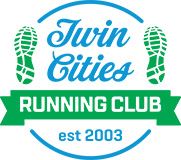| Twin Cities Running ClubA club for beginners and experienced runners alike |
- Home
- Group Runs
- Running Guides
- Winter Running Guide
Winter Running Guide In Minnesota, winter is pretty much unavoidable. Don't despair, though! Winter training has its challenges, but for many runners, it's the best season of all. A few hints should make your winter training more enjoyable: The hardest step to take is the first. Get out the front door, and you'll be glad you did. Dress properly! Winter in Minnesota does mean cold temperatures, snow, ice, and the occasional wind chill. If you prepare for winter conditions, however, your runs can be very comfortable. Don’t overdress! You may be surprised at how little clothing is really necessary to be comfortable running in winter. It's best to be a little chilly when you start out. As you run, you will generate a lot of heat, and you will warm up quickly. Layering is the way to go. Depending on how cold it is, you may need up to three layers:
As a general rule, wear one more layer on your upper body than on your legs. Zippered clothing is great, because it allows you to zip up when you could use some added warmth, and down when you could use a little cooling. Just make sure that cold metal zipper isn't right next to your skin! Ventilation in a jacket, in the form of a back vent and zippered front or side vents, can make for a more comfortable run. That way, if you do get over-heated, you can open a few vents to cool off. This is more important with waterproof jackets, which tend to be less breathable. Make sure your clothing has pockets. In the winter, you tend to carry more items, adding an extra pair of gloves, for example, to your keys. Mittens are better than gloves on really cold days, and always wear a hat! If your head and hands are warm, the rest of your body will follow. In colder weather, layering is a good idea here too. Get two pair of shoes and alternate them. Especially on those "warmer" winter days (and once the snow starts to melt in spring), your shoes will get wet, so it's best to allow one pair to dry out while you wear the other. A little Vaseline/petroleum jelly on exposed areas is helpful on the coldest days—it gives your skin a needed layer of insulation, and washes off easily. Carry a cell phone in the event of an emergency. Check the weather conditions before heading out.That way, you can know what measures to take. Remember wind chill. Winter in Minnesota tends to be windy, and that wind can make it feel much colder than the thermometer might indicate.The wind chill can be calculated at https://www.weather.gov/epz/wxcalc_windchill,or you can use the chart at https://www.weather.gov/safety/cold-wind-chill-chart. And remember that your running speed affects the wind chill, so if you’re running at a 10:00 mile pace (6 mph), add that to the wind speed. Be sensible. Sometimes, the weather is just too bad for an outdoors run. If the wind chill is -55° and the snow drifts are making driving difficult, it won't do you much good to go out and get frostbitten and lost. So try an easy run on an indoor track or treadmill if one is available, get that stationary bike out of the closet, or kick back and watch your favorite movie. Consistency is good, but common sense is even better. Warm up. Muscles are not as pliable in the cold, and your lungs and heart have to adjust to the greater demands put on them. So start out slow. Run defensively. Snow, ice, and dark are a potentially dangerous combination. If you run when it’s dark, cars will have a harder time seeing you, and will have a harder time stopping or maneuvering on snow and ice. So give vehicles additional room for stopping and maneuvering, and be alert to what's happening around you. Wear bright and reflective clothing for the same reason. Wearing all black at night is definitely not a good idea, and wearing all white isn't enough—reflective strips on your clothing are essential, and warning flashers are even better. Slow down. In the summer, you have a firm running surface, which allows you to push off with your toes, increasing your pace. In the winter, you'll slip if you try that. So run more flat-footed, don't toe off, and be comfortable with a slower pace. Once the snow melts, your pace will increase with little or no additional effort. Run into the wind at the start of your run, and with the wind at your back at the end. The last thing you want to do is to get all sweaty running with the wind at your back, then have to turn into a cold wind when you're soaked and tired. Drink as much in the winter as you do in the summer. Cold weather depresses your thirst response, and increases the amount of water lost in respiration and urination, so you have to work to stay properly hydrated. Enjoy it! Get out and enjoy the charms of winter, and the months will fly by. Stay inside and grumble about the cold, and cabin fever will quickly set in. With the right attitude, your winter training can be both productive and enjoyable. |
